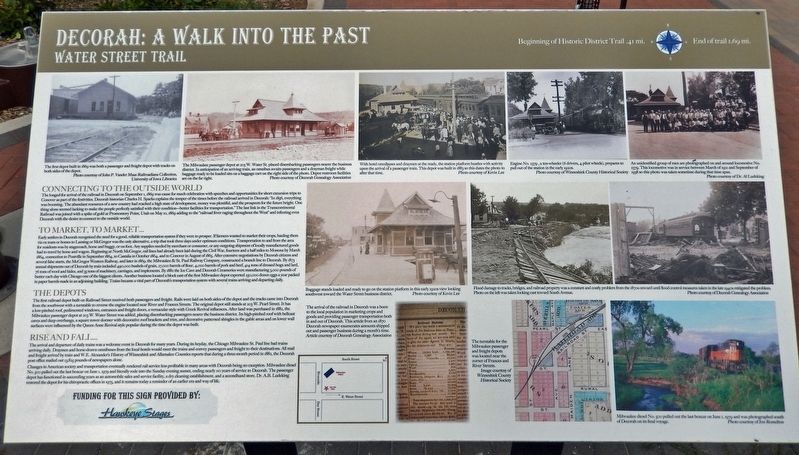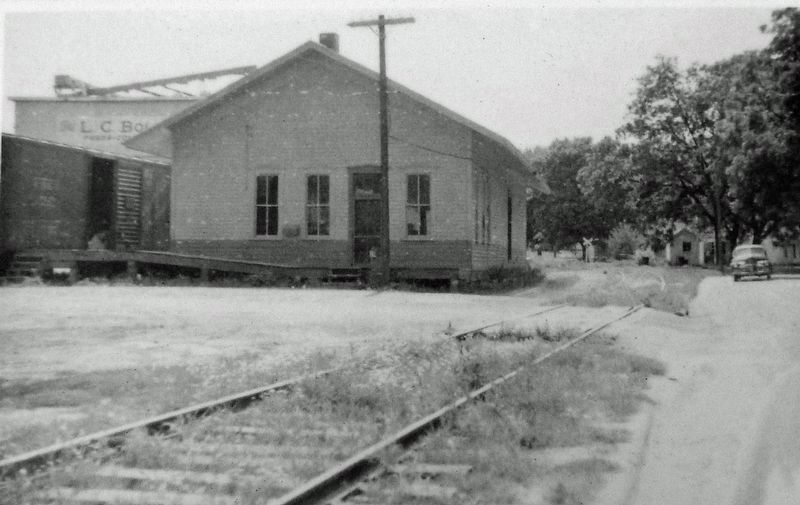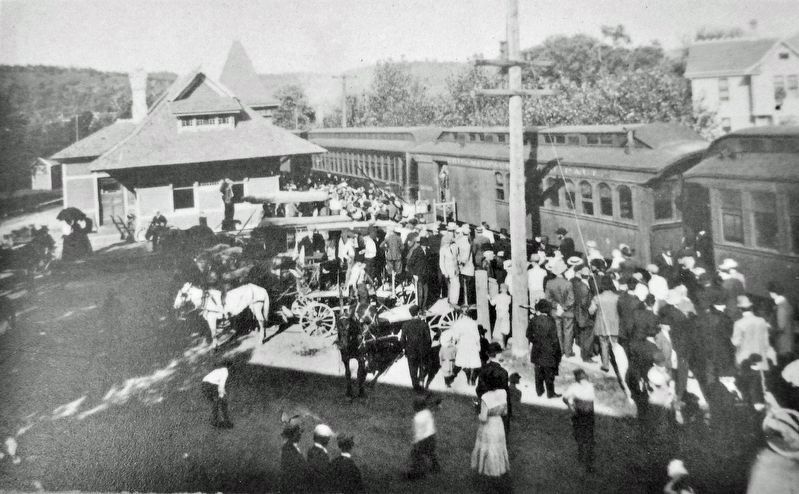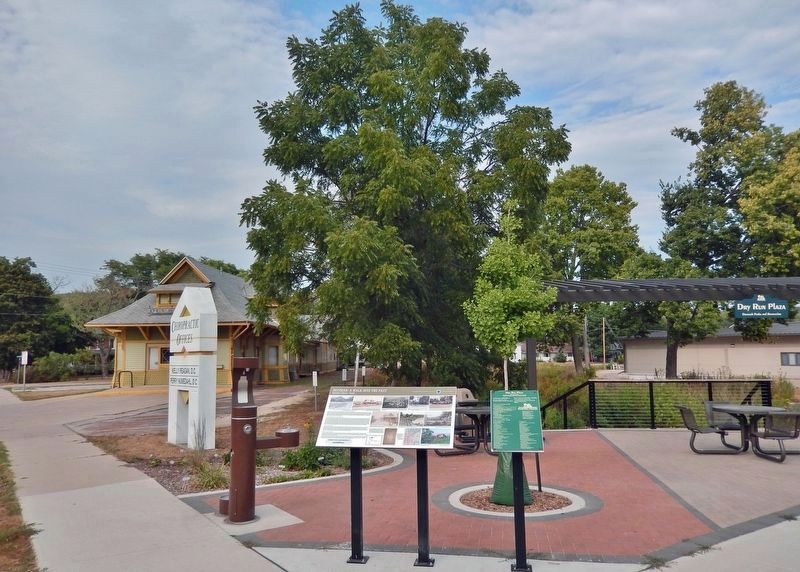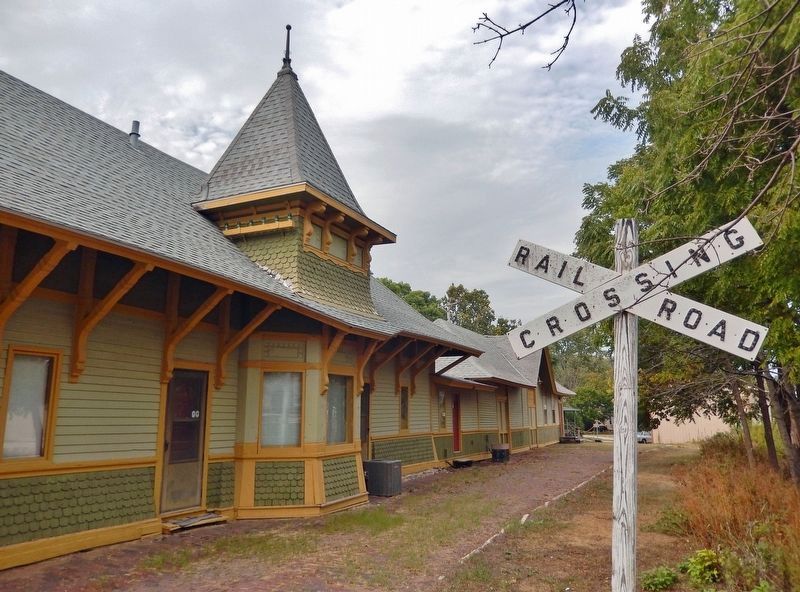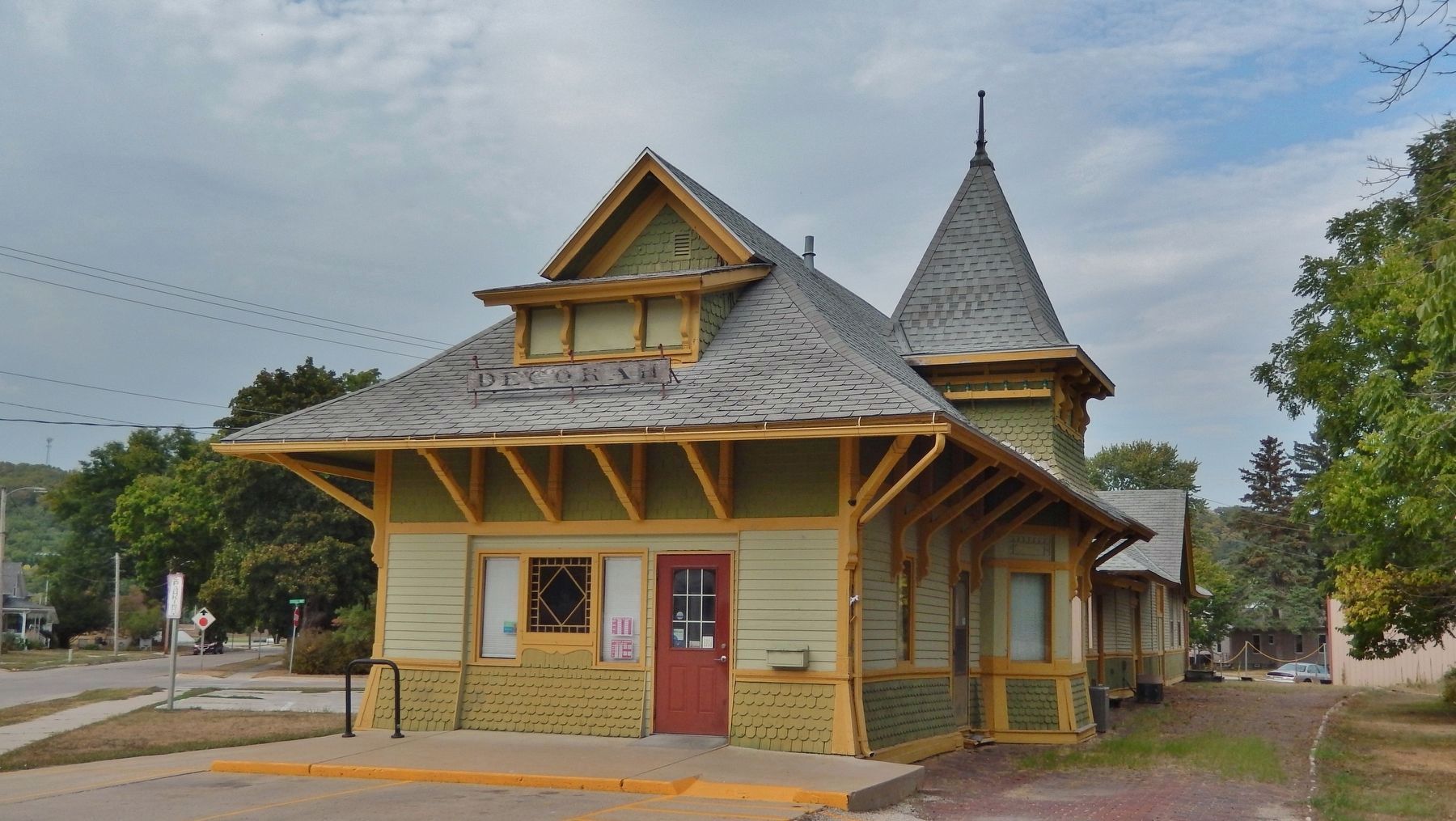Decorah in Winneshiek County, Iowa — The American Midwest (Upper Plains)
Decorah: A Walk into the Past
Water Street Trail
Connecting to the Outside World
The longed-for arrival of the railroad in Decorah on September 1, 1869 was cause for much celebration with speeches and opportunities for short excursion trips to Conover as part of the festivities. Decorah historian Charles H. Sparks explains the temper of the times before the railroad arrived in Decorah: “In 1856, everything was booming. The abundant resources of a new country had reached a high state of development, money was plentiful, and the prospects for the future bright. One thing alone seemed lacking to make the people perfectly satisfied with their condition — better facilities for transportation.” The last link in the Transcontinental Railroad was joined with a spike of gold at Promontory Point, Utah on May 10, 1869 adding to the “railroad fever raging throughout the West” and infecting even Decorah with the desire to connect to the outside world.
To Market, to market…
Early settlers in Decorah recognized the need for a good, reliable transportation system if they were to prosper. If farmers wanted to market their crops, hauling them via ox team or horses to Lansing or McGregor was the only alternative, a trip that took three days under optimum conditions. Transportation to and from the area for residents was by stagecoach, horse and buggy, or on foot. Any supplies needed by merchant or consumer, or any outgoing shipment of locally manufactured goods had to travel by horse and wagon. Beginning at North McGregor, rail lines had already been laid during the Civil War, fourteen and a half miles to Monona by March 1864, connection to Postville in September 1864, to Castalia in October 1864, and to Conover in August of 1865. After extensive negotiations by Decorah citizens and several false starts, the McGregor Western Railway, and later in 1869, the Milwaukee & St. Paul Railway Company, constructed a branch line to Decorah. By 1873 annual shipments out of Decorah by train included 490,000 bushels of grain, 27,000 barrels of flour, 4,000 barrels of pork and beef, 414 tons of dressed hogs and lard, 76 tons of wool and hides, and 35 tons of machinery, carriages, and implements. By 1882 the Ice Cave and Decorah Creameries were manufacturing 3,000 pounds of butter each day with Chicago one of the biggest clients. Another business located a block east of the first Milwaukee depot exported 250,000 dozen eggs a year packed in paper barrels made in an adjoining building. Trains became a vital part of Decorah's transportation system with several trains arriving and departing daily.
The Depots
The first railroad depot built on Railroad Street received both passengers and freight. Rails were laid on both
sides of the depot and the tracks came into Decorah from the southwest with a turntable to reverse the engine located near River and Frances Streets. The original depot still stands at 203 W. Pearl Street. It has a low-pitched roof, pedimented windows, entrances and freight doors, a vernacular style with Greek Revival influences. After land was purchased in 1882, the Milwaukee passenger depot at 203 W. Water Street was added, placing disembarking passengers nearer the business district. Its high-pitched roof with bellcast eaves and deep overhangs, a square tower dormer with decorative roof brackets and trim, and decorative patterned shingles in the gable areas and on lower wall surfaces were influenced by the Queen Anne Revival style popular during the time the depot was built.
Rise and Fall…
The arrival and departure of daily trains was a welcome event in Decorah for many years. During its heyday, the Chicago Milwaukee St. Paul line had trains arriving daily. Draymen and horse-drawn omnibuses from the local hotels would meet the trains and convey passengers and freight to their destinations. All mail and freight arrived by train and W.E. Alexander's History of Winneshiek and Allamakee Counties reports that during a three-month period in 1882, the Decorah post office mailed out 13,825 pounds of newspapers alone.
Changes in American society
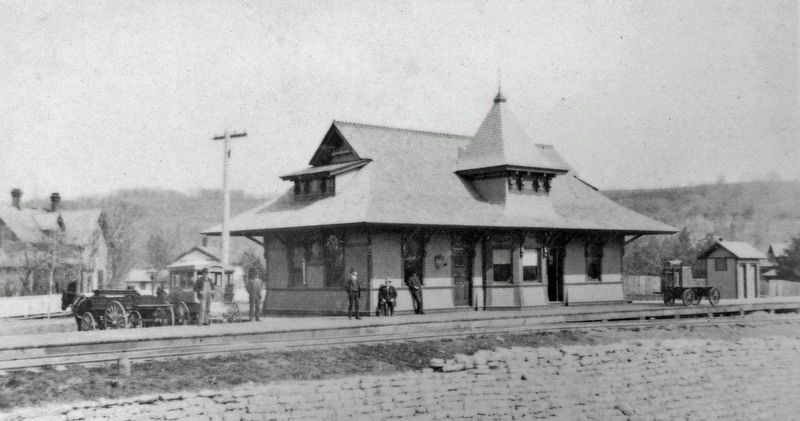
Courtesy Decorah Genealogy Association
3. Marker detail: Milwaukee Passenger Depot
The Milwaukee passenger depot at 203 W. Water St. placed disembarking passengers nearer the business district. In anticipation of an arriving train, an omnibus awaits passengers and a drayman freight while baggage ready to be loaded sits on a baggage cart on the right side of the photo. Depot restroom facilities are on the far right.
[other photo captions]
• Engine No. 2379, a ten-wheeler (6 drivers, 4 pilot wheels), prepares to pull out of the station in the early 1920s.
• An unidentified group of men are photographed on and around locomotive No. 2379. This locomotive was in service between March of 1921 and September of 1938 so this photo was taken sometime during that time span.
• Baggage stands loaded and ready to go on the station platform in this early 1920s view looking southwest toward the Water Street business district.
• The arrival of the railroad in Decorah was a boon to the local population in marketing crops and goods and providing passenger transportation both in and out of Decorah. This article from an 1870 Decorah newspaper enumerates amounts shipped out and passenger business during a month's time.
• The turntable for the Milwaukee passenger and freight depots was located near the corner of Frances and River Streets.
• Milwaukee diesel No. 500 pulled out the last boxcar on June 1, 1979 and was photographed south of Decorah on its final voyage.
Funding for this sign provided by: Hawkeye Stages
Topics and series. This historical marker is listed in these topic lists: Architecture • Industry & Commerce • Railroads & Streetcars • Settlements & Settlers. In addition, it is included in the National Register of Historic Places series list. A significant historical date for this entry is September 1, 1869.
Location. 43° 18.257′ N, 91° 47.001′ W. Marker is in Decorah, Iowa, in Winneshiek County. Marker is at the intersection of East Water Street and Riverside Avenue (Day Street), on the right when traveling west on East Water Street. The marker is located along the sidewalk at the northeast corner of the intersection. Touch for map. Marker is at or near this postal address: 301 East Water Street, Decorah IA 52101, United States of America. Touch for directions.
Other nearby markers. At least 8 other markers are within walking distance of this marker. A different marker also named Decorah: A Walk into the Past (about 300 feet away, measured in a direct line); a different marker also named Decorah: A Walk into the Past (about 400 feet away); a different marker also named Decorah: A Walk into the Past
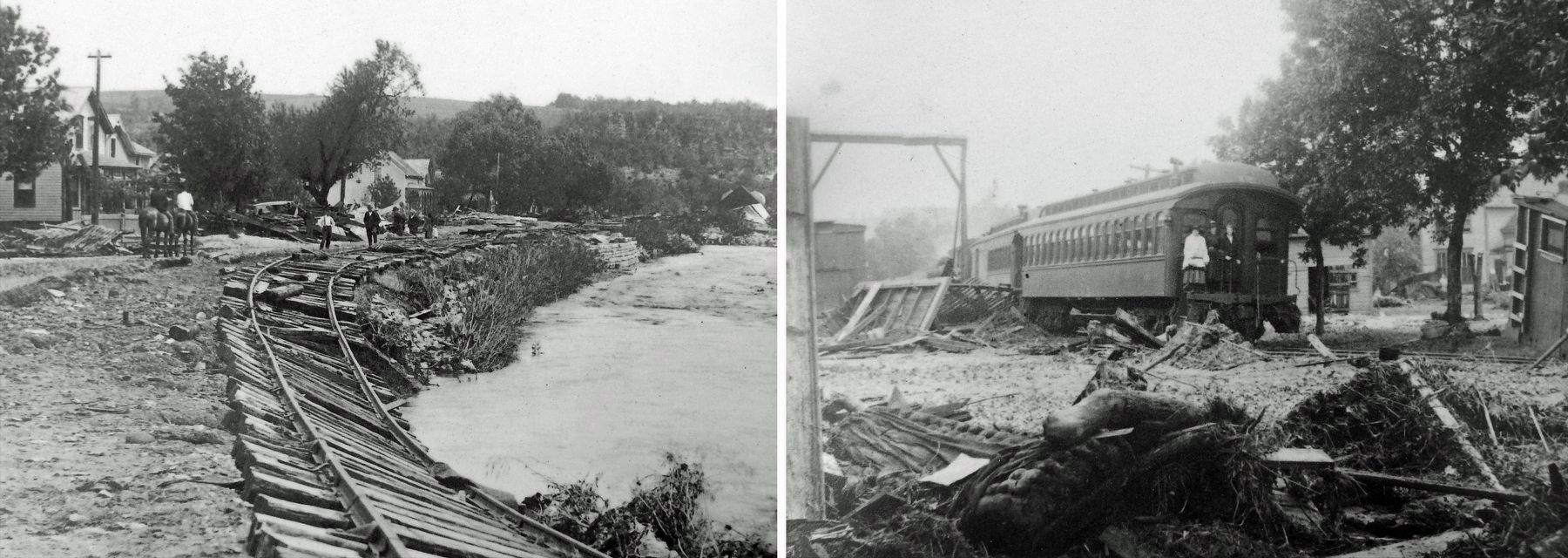
Courtesy Decorah Genealogy Association
5. Marker detail: Flood Damage
Flood damage to tracks, bridges, and railroad property was a constant and costly problem from the 1870s onward until flood control measures taken in the late 1940s mitigated the problem. Photo on the left was taken looking east toward South Avenue.
Regarding Decorah: A Walk into the Past.
Milwaukee and St. Paul Railway Combination Depot, 203 W. Pearl Street
National Register of Historic Places #16000609.
From the National Register Nomination:
Constructed by the Milwaukee & St. Paul Railway for its immediate use in 1869, the combination depot is located in south-central Decorah, Iowa, on level land about eight blocks south of Water Street. The gable-roofed depot was aligned parallel to this right-of-way, which ran southwest/northeast. Its main entrance doorway is on the northeast gable end, with larger freight doorways on either long side walls. It was converted to a freight depot following construction in 1888 of a new passenger depot on Water Street. The Milwaukee & St. Paul Railway Combination Depot in Decorah, Iowa is the city’s oldest railroad depot and one of the few remaining railroad-related resources of any type in the town. Built in 1869, two decades after the town was established, the Milwaukee railway officials were enticed by local boosters to build a short branch line to town after bypassing Decorah with its main northbound line. City leaders wanted to make sure their town would be connected to the lucrative distant markets reached through the Milwaukee’s main line. Without that life line to the greater markets, the town’s continued growth could not be assured. The depot is one of the few remaining wooden depots left in the state, and surely one of its oldest wooden depots, a rare remnant of the first generation of railroad companies and train depots in Iowa.
Also see . . . Milwaukee and St. Paul Railway Combination Depot (Wikipedia). Excerpt:
The tracks were completed in 1869, and a boxcar served as the first depot. That same year this single-story, wood-frame structure with Greek Revival features was completed south of the central business district. It served as a combination depot, servicing both passengers and freight. After the arrival of the Chicago, Rock Island and Pacific Railroad in 1884 the Milwaukee Road started to plan a new passenger depot in Decorah. It was completed on the east end of the main commercial street in 1888. When it opened, this building continued to serve as a freight depot. Over the years its platforms were shortened, and sometime between the 1930s and the 1950s, the southwest end of the building was shortened. The Milwaukee Road abandoned the depot in 1971, and the tracks that flanked the building were removed the same year. The former depot itself was renovated for non-railroad use.(Submitted on February 15, 2024, by Cosmos Mariner of Cape Canaveral, Florida.)
Credits. This page was last revised on February 15, 2024. It was originally submitted on February 14, 2024, by Cosmos Mariner of Cape Canaveral, Florida. This page has been viewed 81 times since then. Photos: 1, 2, 3, 4, 5, 6, 7, 8. submitted on February 15, 2024, by Cosmos Mariner of Cape Canaveral, Florida.
